Jean-Michel Basquiat, Untitled (Portrait of Famous Ballplayer), 1981 (left) and Untitled (ELMAR), 1982 (right) on view at Phillips New York. Modern & Contemporary Art Evening Sale New York.
The symbols seen in the works of Jean-Michel Basquiat form a visual lexicon that has become a ubiquitous part of contemporary culture. From crowns, masks, and skulls to snakes, warriors, and ballplayers, his iconography endures well beyond the canvas, adorning luxury items and mass market goods alike. But what are the connotations of these symbols and are the associations they seem to denote what Basquiat directly intended by them?
Approaching the answers requires the weaving of a complex tangle of associations. Seen as a whole, the various iconographic symbols in Basquiat’s compositions are utterly communicative, but they are so resonant with each other across all his works that it can be challenging to pin down exactly what they express individually. Basquiat was an omnivorous lover of history and lifelong researcher and observer of culture and art — ranging from the Haitian and Puerto Rican cultures of his own background to Medieval Christian traditions, the Warholian notion of celebrity, Rauschenberg’s sense of accumulation, De Kooning and Pollock’s approach to abstraction, Charlie Parker’s improvisation, early hip-hop, modern urban life, and more. Drawing on this myriad of influences, he imbued his works with a diverse and recurring sequence of allusive signs that make viewers feel intuitively clued-in, even if their definitive meanings can remain poetically elusive. This is perhaps the principal reason why his works consume the attention of viewers in any room in which they are placed. In short, they seem to speak with a distinctly human voice, ultimately feeling as ancient as the paintings in the caves of Lascaux, yet as new as anything made today.
To explore these ideas, we look to three magnificent works from the artist’s pivotal years of 1981 and 1982 — Untitled (ELMAR), Untitled (Portrait of Famous Ballplayer), and Native Carrying Some Guns, Bibles, Amorites on Safari, each formerly from the original collection of Francesco Pellizzi and the Pellizzi Family. A writer, scholar, anthropologist, and collector, Mr. Pellizzi was the co-founder and editor of the journal Res, Anthropology and Aesthetics, published by the Peabody at Harvard and Chicago University Press. He acquired these works in the early 1980s from Annina Nosei — Basquiat’s first gallerist — and they remained in his collection for decades. They are on offer in public for the first time this May at Phillips’ Modern & Contemporary Art Evening Sales in New York and Hong Kong. Together, these three works provide a striking opportunity for us to discover just what Basquiat’s inextinguishable voice intones.
From Iconic Street Artist to Rising Star of the Art World
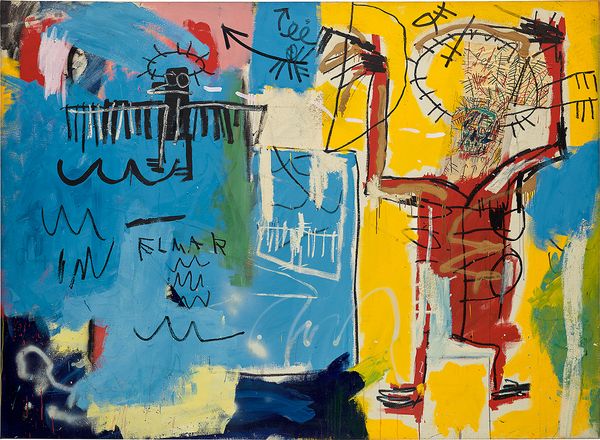
Jean-Michel Basquiat, Untitled (ELMAR), 1982. Modern & Contemporary Art Evening Sale New York.
The years these works were made — 1981 and 1982 — were transformative for Basquiat, as he was caught up in a meteoric ascension from street artist to an almost mythic figure of renown within the global art world. Considering the practice of street artists leads us to question how and why these artists employ a personal iconography to communicate. The risks associated with creating such work present an inherent need to produce imagery simply and quickly — imagery that is paired down to its core — and to build a set of distinctive symbols or text that combine with an approach to color, line, and form that immediately identifies an artist’s work to those who see it in public, often repeatedly and in series.
This exploration of ideas in visual units proved fruitful for Jean-Michel Basquiat, an artist known to have been a voracious consumer of culture past and present, from books on a multitude of subjects through to nearly all genres of music, television, film, and more. Looking at these pivotal paintings, we find several visual ideas Basquiat explored in his early street art days — particularly in his depiction of rounded, stylized heads and his approach to text — but can observe their transcendence within the fine art context; one in which the young artist would have been strongly aware of the fact that his works now had a sense of permanence, no longer at risk of erasure by authorities or other street artists.
From this vantage point, a unique similarity emerges between street art and the world of fine art galleries. In street art’s use of signs and symbols of personal iconography to communicate directly to a particular population of well-informed people, it finds a parallel in certain aspects of the fine art ecosystem that can be seen to do the same — but perhaps for a different group of people. In essence, just as there is a colorful world of people-in-the-know within the realm of a street art context, so too is there within the highest echelons of the art world. And one of the elements that makes Basquiat’s works so culturally resonant is that he was able to communicate to both with great facility.
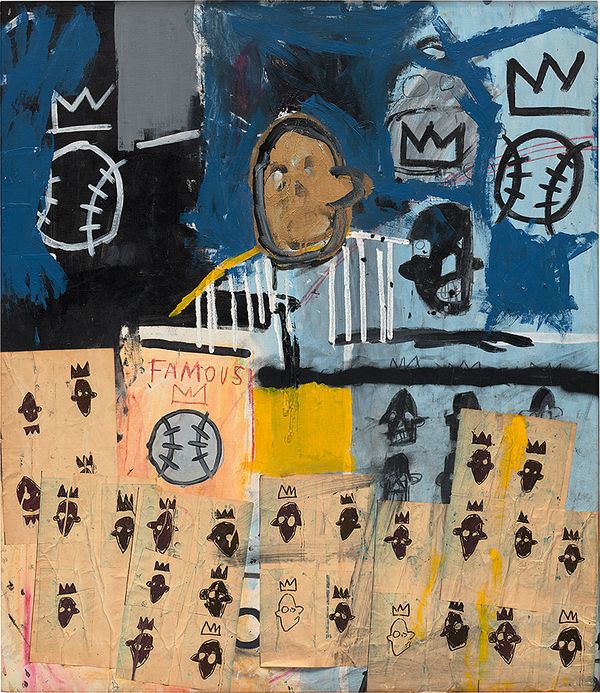
Jean-Michel Basquiat, Untitled (Portrait of Famous Ballplayer), 1981. Modern & Contemporary Art Evening Sale New York.
The often flattened and graphic manner in which Basquiat executed symbols and words seems cartographic at times, as if to imply relationships between them. One can find such connections between the hunter and the hunted in Untitled (ELMAR) and Native Carrying Some Guns, Bibles, Amorites on Safari or between the tools of the iconic athlete (in this case baseballs) and the elevating social function of crowns in Untitled (Portrait of Famous Ballplayer). But the sheer proliferation of symbols and text, both within individual works and across Basquiat’s work as a whole, can add ambiguity to their meanings. In their pure visual relationships to each other, even within a single work, they contain multitudes of intentions and associations that are often elevated, functioning at a level above simple text, image, or glyph. This is something Professor Pellizzi understood well, writing in his 1989 essay Black and White All Over: Poetry and Desolation Painting: “There is no way to make sense of the sum of all this, nor can it be reduced to any of its parts, for there is no hierarchy to guide us in distinguishing what is central from what is peripheral.”
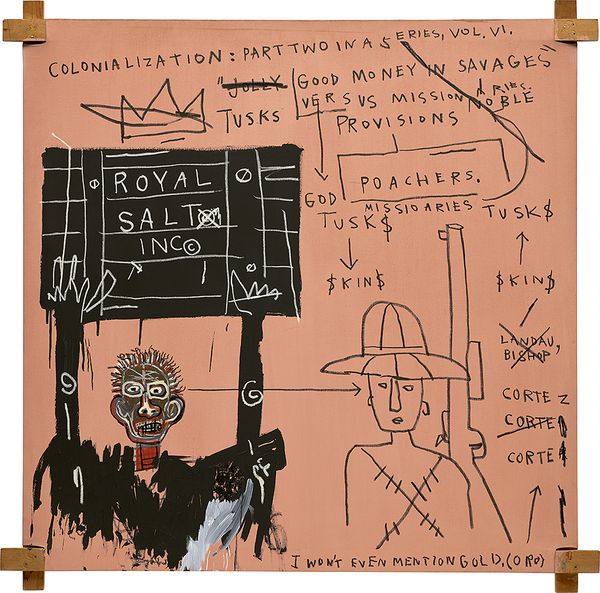
Jean-Michel Basquiat, Native Carrying Some Guns, Bibles, Amorites on Safari, 1982. Modern & Contemporary Art Evening Sale Hong Kong.
Symbols and Meanings

The “warrior” figure, his face depicted as a skull, wearing a crown of thorns. Jean-Michel Basquiat, Untitled (ELMAR) (detail), 1982. Modern & Contemporary Art Evening Sale New York.
To begin to decode the meanings suggested by the symbols in these works, we first consider the image of the head, and by extension its relationship to other important iconography in Basquiat’s works — skulls, masks, and crowns. In Untitled (ELMAR), a warrior-like figure — a recurrent symbol in Basquiat’s works — is depicted at right, its head expressed by a skull. The collage-like treatment here adds emphasis, like an accented note in a Bepop trumpet solo, and it stands in contrast to the rest of the painting’s surface texture. The recurrence of skulls and bones in Basquiat’s work traces back to his early interest in anatomy, having pored over the book Gray’s Anatomy as he recovered from a childhood accident. In Untitled (Portrait of Famous Ballplayer), the prominent anonymized face of a Black athletic icon is obscured, his expression seemingly erased. Elsewhere in the painting, masks are pervasive and often topped with crowns, at once readable as the faces of an adoring crowd or the clamoring, antagonistic gatekeepers of culture. And in Native Carrying Some Guns, Bibles, Amorites on Safari we find that Basquiat’s rendering of the left figure’s countenance is mask-like.

Jean-Michel Basquiat, Native Carrying Some Guns, Bibles, Amorites on Safari, 1982 (detail of the figure at left). Modern & Contemporary Art Evening Sale Hong Kong.
In these symbols, we can observe varying approaches to a visual expression of identity. For example, we can consider masks as a metaphor for the outward construction we employ in a battle with how we are perceived. This contrasts with the notion of the skull which can be seen to function as the innate structure on which our flesh and identities are constructed. Both masks and skulls impart a multitude of connotations and can be considered in relation to the African and Indigenous spiritual practices that Basquiat studied, and even referential to the memento mori of Western art historical traditions. For Basquiat at this time, such considerations of identity would have been top of mind as he metaphorically battled with culture, ever aware of how he was being presented and perceived.
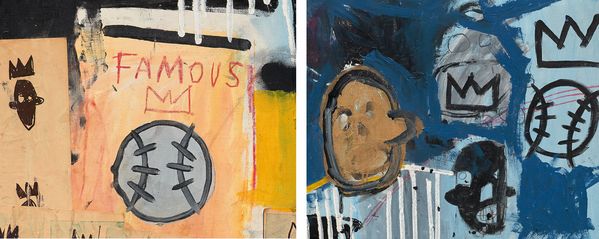
Baseballs and masks adorned with crowns. Jean-Michel Basquiat, Untitled (Portrait of Famous Ballplayer), 1981 (details). Modern & Contemporary Art Evening Sale New York.
The use of the crown in Basquiat’s work can elevate figures to a higher metaphysical and spiritual plane — crowning the idea of a Black King within the world of athletics in Untitled (Portrait of Famous Ballplayer) and adding significance to the message atop the Native figure’s sign in Native Carrying Some Guns, Bibles, Amorites on Safari. We can consider this in contrast to the concept of the crown of thorns (another recurring motif in Basquiat’s work) on both the “warrior” and “fallen angel” figures in Untitled (ELMAR), each employing a Christian allusion to denote a downfall. Again we can consider these ideas within the actuality of Basquiat’s own life at the moment these works were executed. Basquiat wore his newfound celebrity proudly but with an increasing fear that he would fall from the graces of a vapid culture, well aware of the fact that his metaphorical crown of stardom may in fact be a crown of thorns.
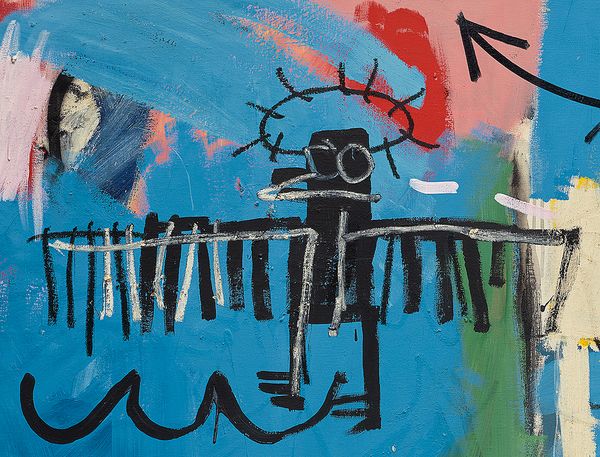
The bird-like “fallen angel” figure wearing a crown of thorns. Jean-Michel Basquiat, Untitled (ELMAR) (detail), 1982. Modern & Contemporary Art Evening Sale New York.
In these three works, the ways symbols function together are rich with meaning, with the symbols often having a resonance in contradiction with each other. For instance, on close consideration of the relationship between the idea of the hunter and the hunted — seen between the “warrior” figure and the “fallen angel” in Untitled (ELMAR) and between the Native and colonial military figures in Native Carrying Some Guns, Bibles, Amorites on Safari — the distinction between the two ideas can collapse, as by their very nature warriors are also hunted. In considering the bird-like “fallen angel” motif in Untitled (ELMAR), this contradiction is inherent, conjuring the recollection that several noteworthy angels in the Abrahamic religious traditions were themselves warriors. Further, the arrows of weaponry in Untitled (ELMAR) and the directional arrows in Native Carrying Some Guns, Bibles, Amorites on Safari both visually function to connect opposing sections of the canvas, creating movement and direction, but they also form paths between ideas, drawing attention to their complex interplay both visually and ideologically.
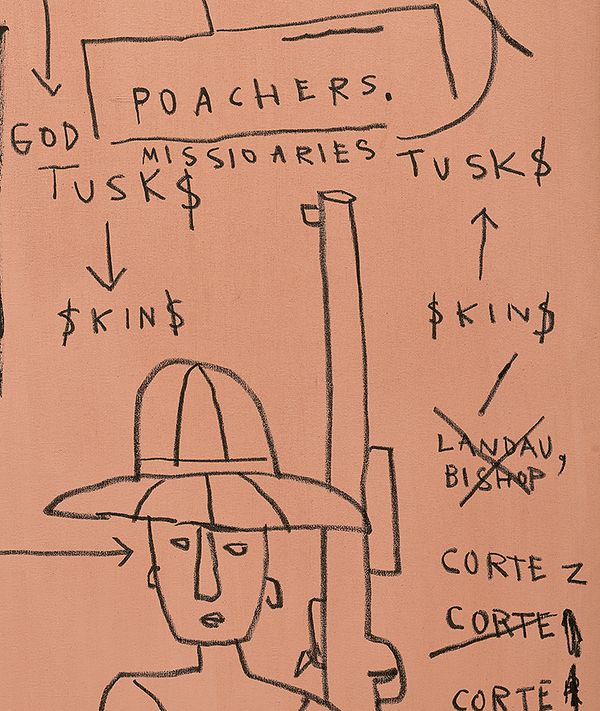
Jean-Michel Basquiat, Native Carrying Some Guns, Bibles, Amorites on Safari, 1982 (detail of arrows and text). Modern & Contemporary Art Evening Sale Hong Kong.
Basquiat’s incorporation of text is seen throughout these three works, but particularly in Native Carrying Some Guns, Bibles, Amorites on Safari. In these works, text also seems to have symbolic function, perhaps due to its placement in proximity to figures and symbols that seem to have speaking power. The artist’s treatment of text as a basic visual material and his careful choice of words, paired with his act of crossing out certain terms for emphasis, creates encoded messages that speak to us in a similar way as his figures. As Pellizzi explains in the aforementioned essay, Basquiat’s words function “like a spell, they can bring things into being and also make them intelligible, can ‘mean’ something and also actually evoke it. In short, it is a sort of depiction, through painting, of language as poetry.”
We also find in these works that for Basquiat, any binary approach towards an understanding of abstraction and figuration dissolves. Basquiat’s iconographic figures are flattened, their meanings abstracted, schematized like a secret code. His approach to painting treats his figures and icons as objects that are as notional and physical as a thrown splash of paint by Jackson Pollock or Joan Mitchell. As Pellizzi explains, Basquiat’s approach to making art can be considered as “a sort of action painting whose starting elements are clusters of primary images and word images right off the brush rather than drips of primary color right out of the can.”
A Personal Language

Jean-Michel Basquiat, Native Carrying Some Guns, Bibles, Amorites on Safari, 1982. Modern & Contemporary Art Evening Sale Hong Kong.
All told, the iconographic imagery within Basquiat’s works forms a visual idiom that is lexical. It communicates like a language that teaches us more about itself as we spend more time with it, rather than imparting a definitive meaning in totality. Perhaps best explained again by Mr. Pellizzi, in his 1989 essay he refers to Basquiat’s iconography as “sign-constructions” that, through the artist’s miraculous painterly skill, attain the functional state of “speaking objects.” This notion conjures the idea of sound and rhythm — some of the basic materials of music, an artform which Basquiat held dear.
The implementation of these “speaking objects” within the context of Basquiat’s spontaneous and improvisational painting practice presents further opportunity for musical analogies that can help decode the artist’s use of a characteristic iconography. In a sense, Basquiat assembled this set of icons, signs, and symbols as part of a personal repertoire, much in the way a jazz musician collects melodic fragments, musical scales from various cultures, and ways of subverting the traditional functions of harmonies — each with a set of connotations that are masked by the musician’s internalization of these sounds within their own musical identity. The directness of both examples stems from an impression that these building blocks of a style or language are primal and innate rather than learned, whereas in fact, the musical materials assembled in the inner ear of a great jazz musician like Basquiat’s hero Charlie Parker were carefully studied, referential to generations of culture, and intentionally prepared to be deployed on the artist’s instrument in a flurry of spontaneous improvisation. For Basquiat, we can see that the same was true, including the creative impulse and directness of approach, but it would be shortsighted to assume his visual materials had not been carefully studied and considered as they were internalized over the years of his practice. And in both cases, the immediate yet ostensibly unrefined nature of the final creative act showcases just how thoroughly each artist absorbed these allusions and reference points within their own expressive identities.
These three works stand as a testament to how compelling and communicative Basquiat’s idiomatic visual language can be. Seen together, the function of iconography in them holds up to the very best of the artist’s works, encompassing imagery that is elemental and allusive. What is perhaps most extraordinary is that though these works draw from and are indebted to a multiplicity of traditions within visual culture, they are not remotely derivative of any one of them, as Basquiat’s cultural receptivity was as strong as his faith in his own artistic identity. With these three paintings, Basquiat absorbed a rich cultural history and weaved it into his own visual signature, creating enchanting works that possess an unquestionable power of voice.
Discover More from Modern & Contemporary Art >
Recommended Reading
BASQUIAT: Property from the Collection of Yusaku Maezawa >
